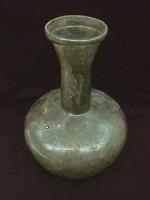Free-Blown Flagon
Free-Blown Flagon
Byzantine, 7th century
blown glass
height 26.4 cm
diameter 17.8 cm
Portland Art Museum European Collection, 36.114
Gift of the heirs of Helen Ladd Corbett
[Author information missing from database]
This piece of Eastern Mediterranean glassware is about 22-25 cm tall, and about 7-9 cm wide. It is a shape variously known as a flagon, a pitcher, or a jug; of a pale green glass, it has suffered some slight weathering in the form of whitish encrustation. The wide mouth narrows quickly to a long neck, which flattens gracefully out into a slightly bulbous body. A wide, ribbed handle and coiled thread around the neck are applied, as may be the base. Pattern-molded ribbing decorates the body.
This free-blown flagon is part of a tradition that begins in the first century A.D., when glassworkers in or around Sidon, a city in Syria, discovered the blowpipe. Glass artistry had been around for many centuries, providing costly ornaments and containers for the upper classes of Egypt, Greece, and Rome, but the advent of blowpipe technology made glassware suddenly cheap and plentiful. The Syria/Palestine area became the center for glasswork in the world of the Late Roman Empire, with the bulk of it imported from that region throughout the various conquered nations.
This particular flagon has been dated seventh to eighth century C.E. and given a Byzantine origin, but I hesitate to rely on this information, if only because it bears many similarities in approximate size, shape, and color to the earlier Late Roman imports of the Syro-Palestinian coastline. Most of the comparative examples were dated from the fourth to the fifth century, although I did find one similar jug from Palestine that was given a possible range of 100-300 C.E. A pitcher in the Corning Museum of glass, dating from the fourth to the fifth century, echoes the applied details of the Portland Art Museum flagon, such as the coils at neck and lip, and the 'celery' style handle, as do several vessels of similar date in the Ernesto Wolf Collection, which are also representative of the general silhouette. The closest match I found is a piece from the Hans Cohn Collection (No. fifty-seven.) Although the shape of the body is different, it is a near twin for color, applied details, and a distinctive ribbed pattern to the body, and dates from the third to the fourth centuries. Another piece in this same collection, matching the Portland Art Museum flagon for shape, is given a range of the second to the fourth century. Most of these pieces were given the general origin of Syria-Palestine, although I found some similar in form from the Black Sea region, as well as slightly northwestern reaches of the Roman Empire.
Even after glass became common in the marketplace, the upper classes still preferred glassware that was vivid in hue, colored to resemble precious stones, or treated so as to be completely colorless, while less costly was naturally a pale greenish tint, due to the presence of iron oxide in the mix of soda, lime, and silica necessary to create glass. This same pale green is the color of the flagon at the Portland Art Museum, contributing to its ubiquity of type.
The item may indeed date from the seventh to eighth centuries C.E., but with no information as to provenance, the flagon in the Portland Art Museum might just as easily be from any century from the second to the seventh, C.E. Although the Late Roman tradition of glass design - including types of this particular flagon - did continue after the fall of the Roman Empire, the Byzantine period began featuring glass vessels of a more ornate character, in some cases the handle devolving into ornamental uselessness. In contrast, the Portland Art Museum flagon has a utilitarian style that enjoyed a wide era of popularity. The spacious body and solid handle are imminently practical. Household items of this type were extremely commonplace; this flagon, probably used for serving liquids in the average home, was no exception.
Bibliography
Hayes, John W. Roman and Pre-Roman Glass in the Royal Ontario Museum. Royal Ontario Museum, Toronto. 1975.
Matheson, Susan B. Ancient Glass in the Yale University Art Gallery. Yale University Art Gallery. 1980.
Neuburg, Frederic. Glass in Antiquity. Art Trade Press, London, England. 1949.
Stern, E. Marianne. Roman, Byzantine, and Early Medieval Glass. Hatje Cantz Publishers, Ostfilden-Ruit, Germany. 2001.
Von Saldern, Axel. Ancient and Byzantine Glass from Sardis. Harvard University Press,Cambridge, Massachusetts. 1980.
---. Ancient Glass in the Museum of Fine Arts Boston. The Meriden Gravure Co., Meriden, Connecticut. 19.
---. Glass 500 B.C. to A.D. 1900: the Hans Cohn Collection. Verlag Philipp von Zabern, Mainz on Rhine. 1980.

